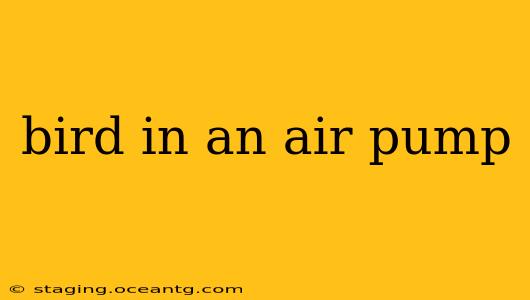The image of a bird trapped in an air pump is unsettling, conjuring up images of struggling wings and desperate chirps. While it might seem like a bizarre, isolated incident, this unfortunately happens more often than many realize. This phenomenon highlights crucial issues concerning bird safety, the design of air pumps, and the importance of responsible practices. Let's delve into the details.
Why Do Birds Get into Air Pumps?
Birds, particularly smaller species, are often drawn to seemingly safe havens—places that offer shelter from predators or inclement weather. The dark, enclosed space of an air pump's intake can appear to be just such a sanctuary. They may be seeking refuge from a storm, looking for a nesting site (however unsuitable), or simply exploring their environment. The unfortunate reality is that once inside, escape is often impossible.
How Do Birds Die in an Air Pump?
The immediate cause of death is typically suffocation. Once inside the air pump's mechanism, the bird is unable to breathe. The rapid movement of air within the pump disrupts airflow and prevents the bird from taking in oxygen. Internal injuries from the moving parts are also a possibility. The experience is undoubtedly terrifying and distressing for the bird.
What types of air pumps are most problematic?
Larger, more powerful air pumps present the greatest risk, due to the strength of their airflow and the difficulty of a bird escaping. Pumps that are left unattended for extended periods, particularly during migratory seasons or when birds are most active, increase the probability of this happening.
Can I prevent a bird from getting into my air pump?
Prevention is far better than dealing with the tragic aftermath. Several steps can drastically reduce this risk:
- Screen the intake: Covering the intake of your air pump with a fine mesh screen will prevent birds from entering while still allowing for proper ventilation. This is the single most effective preventive measure.
- Regular inspection: Check your air pump regularly, especially before turning it on. A quick visual inspection can prevent a potentially fatal incident.
- Strategic placement: Avoid placing air pumps in areas known to attract birds, such as near nesting sites or feeding areas.
- Maintenance schedule: As part of your regular maintenance, check for any blockages in the intake, as this might indicate a previous bird entry that wasn’t noticed.
What should I do if I find a bird in my air pump?
Finding a bird trapped in an air pump is a distressing situation. Immediate action is critical, although, unfortunately, often too late.
- Turn off the pump immediately: This is the first and most crucial step. Do not attempt to remove the bird while the pump is running.
- Carefully remove the bird: Once the pump is off, try to access the bird carefully. If you're uncomfortable, call an animal rescue organization or wildlife rehabilitator for assistance. Never attempt to force the bird out, as this might cause further injury.
- Assess the bird: Once removed, assess the bird's condition. If it appears injured or deceased, contact your local animal control or wildlife rehabilitation centre. They will be able to provide appropriate care or disposal.
Is this a common problem?
While not widely publicized, anecdotal evidence suggests that this issue occurs more frequently than is commonly known. Many incidents go unreported, and the discovery is often too late to save the bird. The lack of widespread awareness about this problem makes preventive measures even more critical.
What can be done to raise awareness?
Increased awareness through educational campaigns, articles, and social media discussions can help prevent future bird deaths. Manufacturers could also explore designing air pumps with integrated bird-deterrent features, improving the safety of their products. The ultimate goal should be to create a safer environment for birds and avoid this preventable tragedy.
By taking simple precautions and raising awareness, we can contribute to creating a safer environment for birds and reduce the number of tragic incidents involving air pumps. Remember, a simple screen can save a life.
